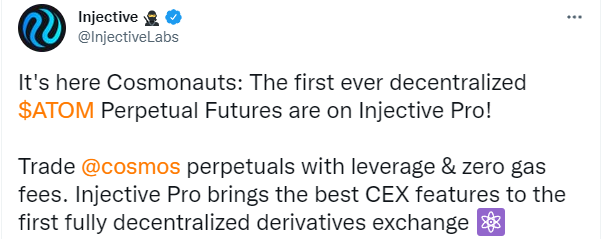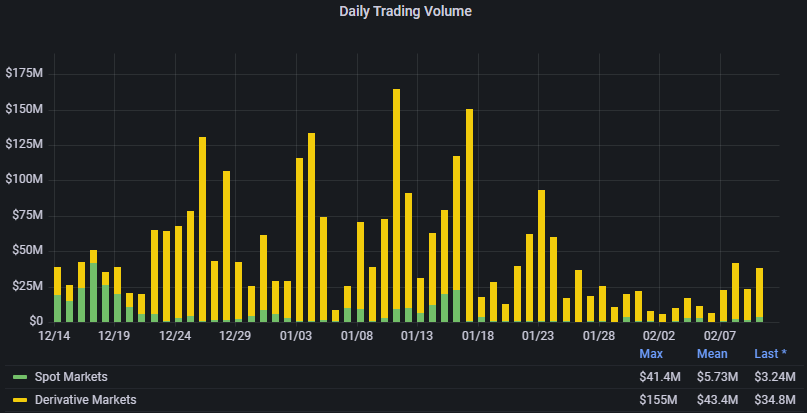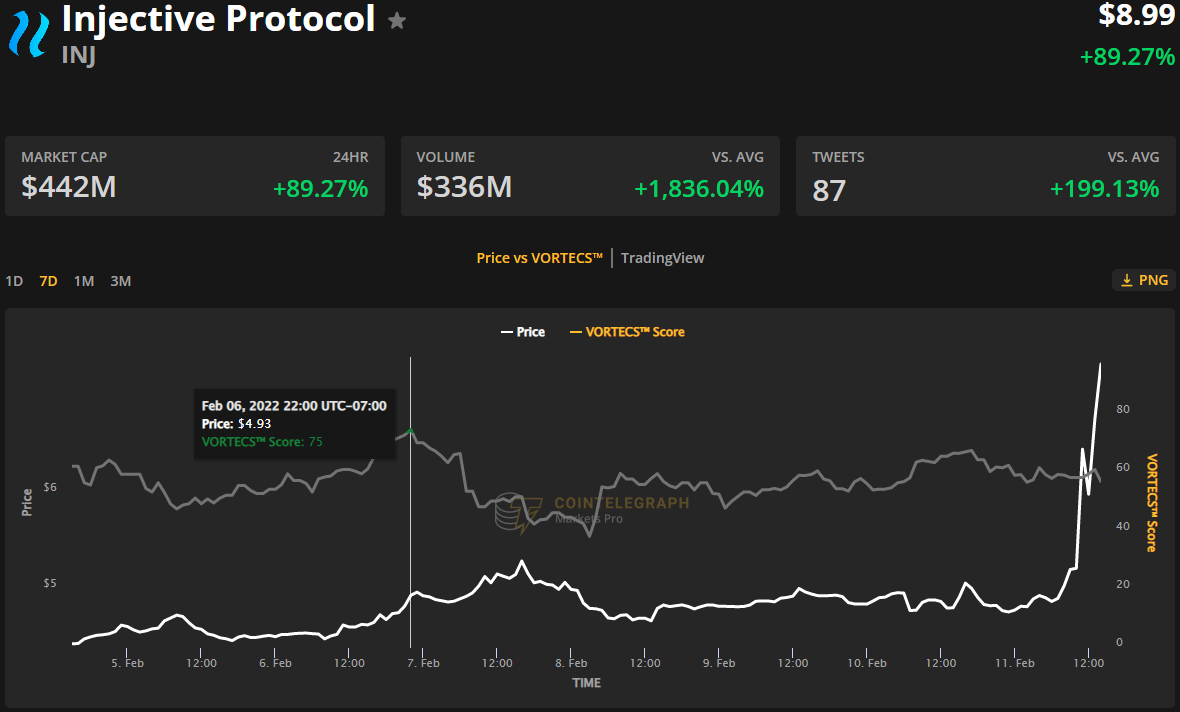Trading perpetual futures contracts in decentralized apps is a crypto sub-sector ripe for growth, especially as discussions of regulation, taxation and mandatory KYC at centralized exchanges continue to take place.
One DEX platform that has begun to gain traction is Injective (INJ), an interoperable layer-one protocol designed to facilitate the creation of cross-chain Web3 decentralized finance (DeFi) applications.
Data from Cointelegraph Markets Pro and TradingView shows that after hitting a low of $3.91 on Feb. 3, the price of INJ has rallied 157.8% to a daily high of $10.08 on Feb. 11 amidst a 1,756% spike in its 24-hour trading volume to $306 million.
 INJ/USDT 1-day chart. Source: TradingView
INJ/USDT 1-day chart. Source: TradingView
Three reasons for the spike in demand for INJ include the addition of support for new assets in spot and perpetual markets, the release of Injective Bridge v2 and a climbing total value locked on the protocol as a result of staking and the addition of new assets.
Injective Bridge v2
The most recent development that helped kick off the price growth for INJ was the release of the Injective Bridge v2 at the end of January, which included a variety of upgrades designed to help facilitate cross-chain compatibility with Cosmos (ATOM) and Ethereum (ETH).
The new Injective Bridge is here!
Injective Bridge V2 brings a vastly superior user experience for all @ethereum and @cosmos users.
The bridge will serve as a core launchpad for new cross-chain Web3 projects looking to deploy on Injective
— Injective (@InjectiveLabs) January 28, 2022
According to Injective, the new bridge is capable of supporting any ERC-20 token and multiple Cosmos-based tokens including ATOM, Osmosis (OSMO) and Terra (LUNA).
Over time, Injective looks to have the bridge become a launchpad of sorts for new Web3 projects that want to allow users to transfer assets from the Ethereum network for zero fees.
There are also zero bridge fees when transferring funds into the Inter-blockchain communication protocol (IBC)-enabled chains.
Injective Protocol adds support for new assets
A second development helping to bring fresh momentum to Injective has been the addition of new assets to the DEX, including the first-ever decentralized perpetual futures for ATOM.

Along with a perpetual futures contract for ATOM, Injective also added spot trading for the Cosmos-based project Chihuahua (HUAHUA) and there is also an active community vote to add Juno.
The addition of new assets helped lead to an increase in trading volume on the protocol over the past few days after hitting its lowest level in several months on Feb. 2.
 Inject DEX daily trading volume. Source: Injective
Inject DEX daily trading volume. Source: Injective
While it has excited the Injective community to see an uptick in trading volume on the protocol, it’s worth noting that the current volume is but a small fraction of the volume seen on the top perpetual futures protocol dYdX, which saw a daily volume of $3.2 billion on Feb. 10 and $2.8 billion on Feb. 11.
Related: Is the rise of derivatives trading a risk to retail crypto investors?
TVL soars
The release of Injective Bridge v2 was also followed by a surge in the total value locked on the platform, and data from DeFi Llama shows the metric hitting a new all-time high.
 Total value locked on Injective. Source: Defi Llama
Total value locked on Injective. Source: Defi Llama
As of Feb. 11, the total value looked on Injective is $147.35 million, an increase of more than $100 million from its low of $43.96 million on Jan. 23.
The TVL on INJ consists of assets that are deposited for trading purposes as well as INJ tokens that are staked on the network earning an APR of 9.15%.
VORTECS™ data from Cointelegraph Markets Pro also began to detect a bullish outlook for INJ on Feb. 6 prior to the recent price rise.
The VORTECS™ Score, exclusive to Cointelegraph, is an algorithmic comparison of historical and current market conditions derived from a combination of data points including market sentiment, trading volume, recent price movements and Twitter activity.
 VORTECS™ Score (green) vs. INJ price. Source: Cointelegraph Markets Pro
VORTECS™ Score (green) vs. INJ price. Source: Cointelegraph Markets Pro
As seen in the chart above, the VORTECS™ Score for INJ spiked into the green zone and hit a high of 75 on Feb. 6, around 39 hours before the price began to increase 117% over the next three days.
The views and opinions expressed here are solely those of the author and do not necessarily reflect the views of Cointelegraph.com. Every investment and trading move involves risk, you should conduct your own research when making a decision.






